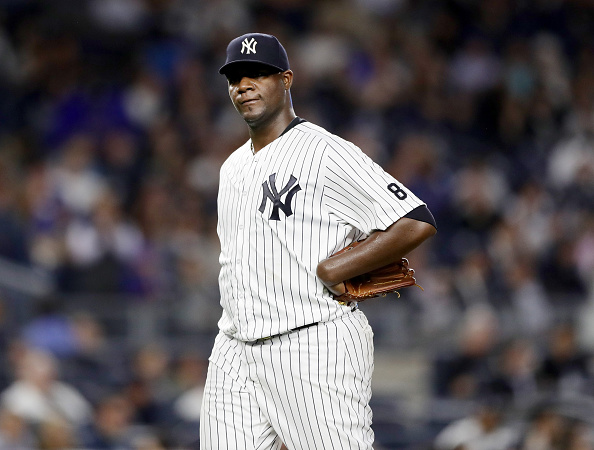It’s safe to say that Michael Pineda could be considered one of the more frustrating aspects of this 2016 New York Yankees team. But what’s important to note here, is the use of the word “frustrating” versus a word like “disappointing,” or a phrase like “he makes me pull my hair out in clumps.” And that’s because frustrating denotes a sense of the good often being overshadowed by the bad.
Pineda has great moments, good starts, and well put-together innings, only to then dash your hopes with terrible starts, boneheaded decisions and the body language of a frustrated 12-year-old. But with talented pitching prospects in the minors, and CC Sabathia eyeing a return to the rotation, Pineda is coming up on crunch time when it comes to his career and trajectory as a starter.
One of the most frustrating aspects about Pineda is that he can, at times, appear almost unhittable. Take for instance his body of work between the second and sixth innings in last night’s game against the Royals. He allowed just one hit in that time frame, eventually racking up seven strikeouts during his doomed outing. Unfortunately, Pineda took a beating in the first which is turning into an alarming trend. Pineda is responsible for a 15.43 ERA in the first inning, giving up runs in the first inning in four of his last seven games.
It also seems like his bad starts come at inopportune times. After the Yankees took the first two games of the series with Kansas City, Pineda put the brakes on a small streak to coast to a disappointing loss. Nothing kills momentum quite like a pitcher with such obvious talent letting a game get away. But what’s worse, is Pineda’s obvious and visible frustration and body language when games get away from him.
Pineda frequently lets emotions get in the way of how he controls the game. Minor mistakes will cause distractions leading to, in the case of last night, two-out, three-run home runs. But how do you instill more confidence in a pitcher? And is it too late for Pineda to turn it around at this point?
A good case study to examine when considering the possibility of Pineda turning it around is Jake Arrieta of the Chicago Cubs, a player with a subpar four years in the big leagues before something clicked. From that moment forward, Arrieta has been one of the most dominant pitchers in the league, winning last year’s NL Cy Young award. What was Arrieta’s secret? And more importantly, could it work for Michael Pineda? The short answer, unfortunately, is “maybe?”
So how exactly did Arrieta turn it around? He changed almost everything about his pitching. He tore himself down and rebuilt himself from the ground up. The changes paid off accounting for a 3 run difference in terms of ERA, and a complete turnaround from one of the worst starters to one of the best in the league. And all he had to do was change everything.
The biggest difference was how Arrieta threw strikes. Not only was he getting more first-pitch strikes, but he was throwing more pitches out of the strike zone. Luis Severino has struggled with this early in his career. Good pitchers make bad pitches look good. They also throw a lot of pitches that start in the strike zone and end up outside of it. Pitching like this leads to more ground balls, and less hard contact, both of which lead to less home runs.
But can Pineda, someone who’s notorious for making some boneheaded decisions, muster up the maturity and confidence necessary to make such drastic changes to his pitching process? Luckily, he’s already halfway there.
When batters make contact with Pineda, 44% of that contact is ground balls, followed by 35% fly balls, and a line drive percentage of 21%. Pineda could certainly improve on how many strikes he throws out of the strike zone. His swing percentages are almost negligible outside of the strike zone, and his pitch percentage is relatively low outside of the strike zone, save for an apparent tendency to throw low and inside to lefties. His hottest area is right down the middle.
An effort to change up his location, and find some much needed consistency could go a long way in turning around Pineda’s career. He certainly has the stuff to become a consistently good pitcher and a staple in the rotation.
Keeping in mind that he’s only 27 (and that Arrieta made drastic changes to his pitching around the same point in his career), I think it is certainly logical to be hopeful about Pineda’s future. But if he’s going to turn it around, there’s no better time than now.




